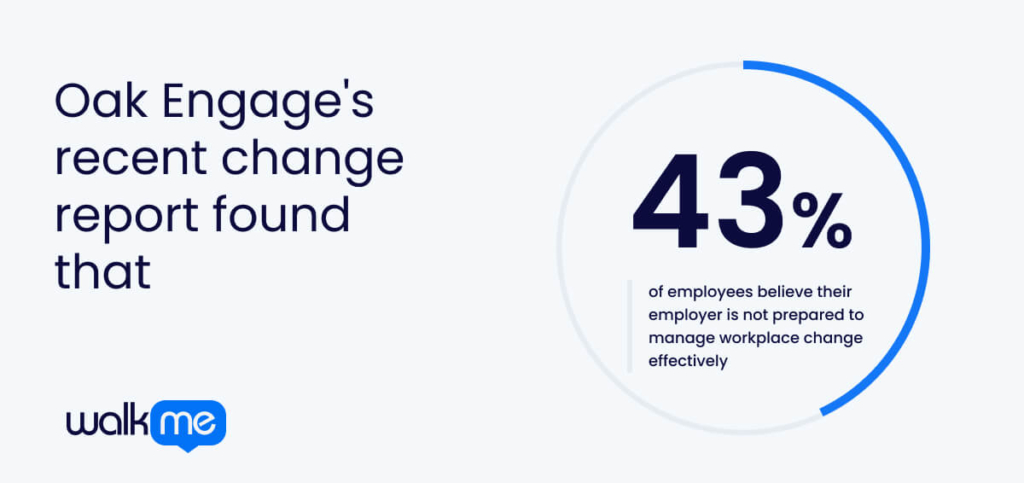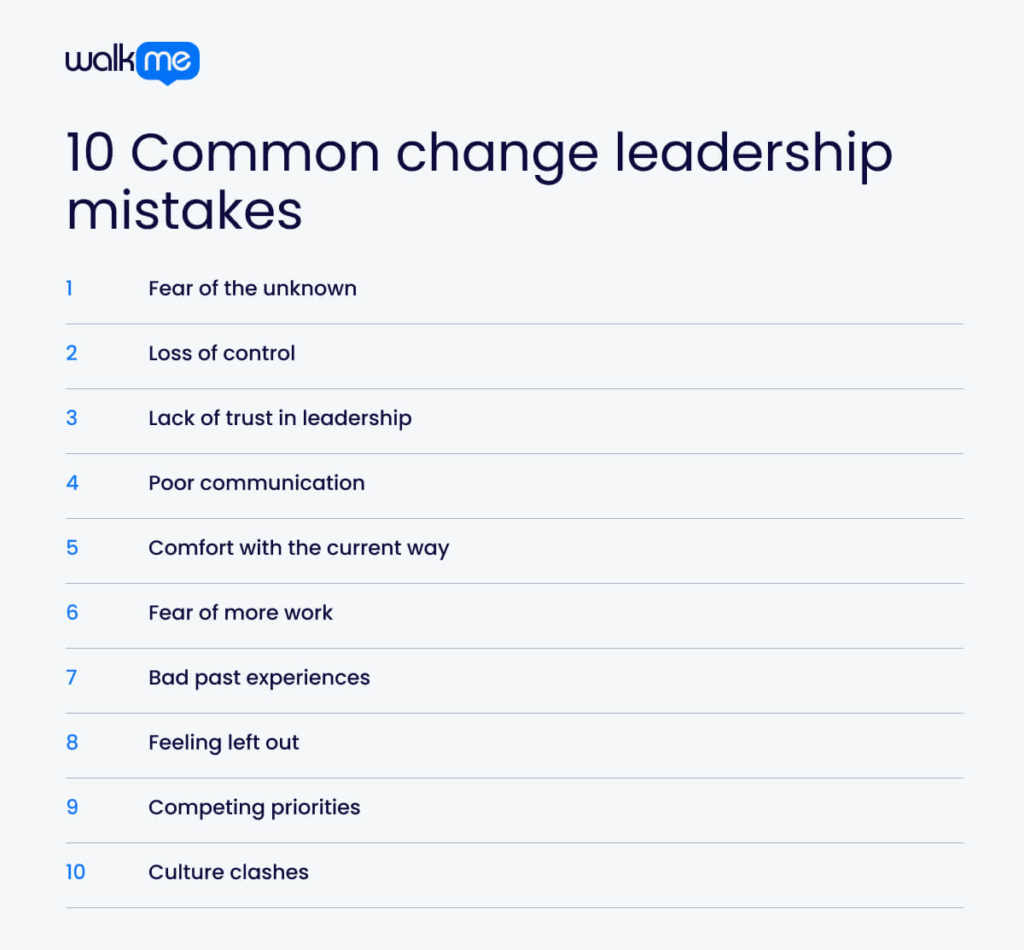Change management is a constant in business, yet many workers resist it.
This can cause even the best change plans to fail. Understanding why people resist change and how to lead through it is vital to helping companies grow and stay competitive.
Oak Engage’s recent change report found that 43% of employees believe their employer is not prepared to manage workplace change effectively.

This article examines change leadership mistakes. We’ll explore what change leadership is, why it matters, and why staff often resist change.
These insights can help you face the hurdles of change. Whether new to leading change or a seasoned pro, this guide can boost your success.
Understanding why workers resist change is crucial and helps leaders craft better strategies. Resistance to change is complex and is rooted in human nature and how companies work.

Let’s look at the main reasons people push back against change and the mistakes leaders often make.
- Fear of the unknown
People often fear what they don’t know. Change brings uncertainty, which can be very unsettling. Our brains are wired to avoid the unfamiliar, which can lead to pushing back against new ideas. Workers might worry about their job safety, fear new duties, or fail at new tasks. This fear can make people cling to what they know, even if it’s not ideal.
For example, some workers might resist a company’s introduction of new software. They might worry they won’t learn it fast enough, or they could fear looking stupid or losing their jobs to someone more tech-savvy.
- Loss of control
Change can make workers feel powerless. This is especially true when change comes from the top down. People like to have a say in their work life. Change can shake up routines, team dynamics, and even where people sit. Workers resist changes imposed on them without input because they want control over their work.
Imagine a company decides to switch to open-plan offices. Workers who are used to private offices might resist. They may feel they’re losing status or the ability to work quietly. This loss of personal space can feel like a big loss of control.
- Lack of trust in leadership
Trust is key in change efforts. If workers don’t trust leaders, they’ll doubt new plans. This mistrust can stem from poor communication or past letdowns. Workers might question the real reasons for change and wonder if hidden motives exist. If past changes have failed, workers may doubt leaders can pull off new ones.
Say a company has had several CEOs in a short time. Each one started big changes but left before finishing them. Workers might not trust the next leader who announces a new direction. They might think, “Why bother? This too shall pass.”
- Poor communication
Bad communication can derail change efforts. Workers need clear information about why change is happening. They need to know how it will help and how it will roll out. When change communication is weak, rumors can spread, increasing worry and resistance. Poor communication can also make workers feel undervalued. They might think their concerns don’t matter.
For instance, workers will fill in the blanks if a company plans to merge departments but doesn’t explain why. They might assume it’s to cut jobs, even if that’s false. Clear, ongoing talks about the reasons and benefits of the merger could ease these fears.
- Comfort with the current way
Many people get comfy with how things are. Even if current methods aren’t great, they’re familiar. Learning new skills or ways of working can be scary. The current setup offers a sense of safety. Workers may have mastered current systems. The thought of being a novice again can hurt their confidence.
Think of a sales team that’s always used cold calling. Asking them to switch to social media marketing might meet resistance. They know they’re good at phone sales. The idea of learning a whole new way of selling could be daunting.
- Fear of more work
Change often means extra effort at first. Workers may fear this extra work won’t pay off. They might worry about long-term increases in their workload. Some may think change is a way to get more work done without more pay. During change, workers might have to keep up with old tasks while learning new ones. This real increase in work can cause stress and pushback.
Imagine a company bringing in a new customer service system. Workers might have to learn the new system while handling their usual call volume. This double duty can be stressful and might make them resist the new system.
- Bad past experiences
If workers have seen changes fail before, they may resist new ones. Past problems can leave a lasting bad taste. Workers may remember the stress and disruption of past changes. This can lead to a “not again” attitude. They might be cynical about claims of benefits. They may not want to put energy into something they think will fail.
For example, if a company tried and failed to launch a new product line before, workers might be skeptical about trying again. They might think, “We’ve been through this before. It didn’t work then; why would it work now?”
- Feeling left out
When workers feel change is forced on them, they resist. They want to have a say. Workers often know a lot about their daily tasks. When this knowledge is ignored, they may feel the change is out of touch. Without involvement, workers may struggle to see the big picture, making it hard for them to get on board with new plans.
Consider a hospital bringing in new patient care procedures. If nurses who work directly with patients aren’t asked for input, they might resist. They might feel their practical experience is being overlooked.
- Competing priorities
Sometimes, new changes clash with other goals. This needs to be clarified for workers. In big companies, different teams may have conflicting aims. For individual workers, changes might not fit their career goals or work-life balance. These conflicts can pull workers in various directions. They may feel torn between new orders and current commitments.
For instance, a marketing team might be told to focus on social media. However, they might also face pressure to meet traditional ad sales targets. This clash of old and new priorities can create stress and resistance.
- Culture clashes
Company culture plays a big role in how change is received. If new plans go against deep-rooted norms, workers may resist. Culture shapes how people act and think at work. When change seems to threaten this foundation, many may push back. For example, a company that values teamwork might resist changes focusing on individual performance.
Imagine a friendly, casual startup deciding to enforce strict dress codes and formal meetings. This could clash with the laid-back culture that attracted many workers. The change might face strong pushback, even if it’s meant to help the company appear more professional to clients.
Avoiding change leadership mistakes
Leading change is hard but crucial. Today’s world is always shifting, and companies must adapt to thrive.
Leaders can plan better and address concerns head-on by grasping why workers resist change.
Good change leadership needs a clear vision and strong people skills. It’s about more than just planning; it’s about guiding people through uncertain times. As markets shift and tech advances, the ability to lead change becomes even more vital.
Companies can set themselves up for success by building strong change leadership skills. They can weather challenges and grab new opportunities.
Remember, change isn’t just about new systems; it’s about people. By focusing on the human side of change, leaders can build a more flexible and successful company.
In the end, effective change leadership can turn resistance into enthusiasm and transform challenges into chances for growth.
With the right approach, companies can endure change leadership mistakes and use them to thrive.
FAQs
Change leaders often fail due to poor communication, lack of employee involvement, underestimating resistance, insufficient planning, or inability to sustain momentum. They may also struggle with unrealistic timelines, inadequate resources, or failure to address organizational culture.
Here are four specific mistakes that leaders frequently make:
- Poor communication
- Lack of employee engagement
- Failing to lead by example
- Neglecting to create a clear vision and strategy
These common mistakes can undermine change efforts and erode trust within the organization.

